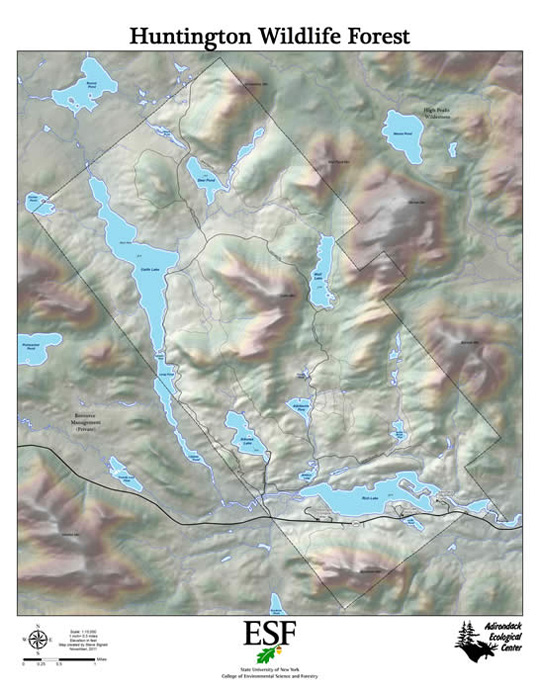Newcomb Campus
Huntington Wildlife Forest
ESF's Newcomb Campus is situated in the magnificent Huntington Wildlife Forest. In 1932, the 15,000 acre (6,000 ha) Huntington Wildlife Forest (HWF) (latitude 44E 00" N, longitude 74E 13" W) was donated by Archer and Anna Huntington for the specific use of SUNY-ESF. Located mostly in the Town of Newcomb, western Essex County, it lies near the geographic center of the Adirondack Park. The purpose of this gift was to establish a field station "for investigation, experiment and research in relation to the habits, life histories, methods of propagation and management of fish, birds, game, food and fur-bearing animals and as a forest of wildlife" (Johnson and Dence 1937).
The topography is mountainous and elevations range from 1500 ft to 2700 ft (457 m to 823 m). Vegetation consists of northern hardwoods (72%), mixed hardwood-conifer (18%), and conifer (10%). Dominant northern hardwood species include American beech (Fagus grandifolia), sugar maple (Acer saccharum), red maple (Acer rubrum), and yellow birch (Betula alleghaniensis). Common conifers are red spruce (Picea rubens),balsam fir (Abies balsamea), hemlock (Tsuga canadensis), white cedar (Thuja occidentalis), and white pine (Pinus strobus). HWF has a mean annual temperature of 40 degrees F (4.4 C) and mean annual precipitation is 40 inches (1010 mm) (Shepard et al., 1989). Upland watershed soils are generally <3 ft in depth and include Becket-Mundell series sandy loams (coarse-loamy, mixed, frigid typic Haplorthods) while Greenwood Mucky peats are found in valley bottom wetlands. Groundwater occurs predominantly in deep near-stream peats (3-10 ft depth), pockets of glacial till in valley-bottoms (0-6.5 ft) and limited zones of glacial outwash deposits. Five lakes ranging in size from 95 to 536 acres (38 to 217 ha) are located with in the boundaries of HWF, all of which are part of the Upper Hudson River Watershed.

History of HWF
Archer Huntington (1870-1955), the adopted child of Collis Huntington, a founder of the Southern Pacific railway, inherited a massive fortune as his only heir. In 1923, after a failed first marriage, Archer married Anna Hyatt (1876-1973). Anna Hyatt Huntington is a sculptor of world renowned whose works grace the main campus of SUNY-ESF, Brookgreen Garden in South Carolina, and New York City. Huntington and Arbutus Lodges, once joined as an original William West Durant Adirondack Camp, served as the Huntington's summer retreat where Archer came to fish and Anna to prepare field studies for her acclaimed sculptures. Both Archer and Anna were passionately fond of animals, particularly wildlife, and donated the property with the intent that it be used "for investigation, experiment and research in relation to the habits, life histories, methods of propagation and management of fish, birds, game, food and fur-bearing animals and as a forest of wild life."
In 1932, ESF established biological surveys on the property and a tradition of research that continues to this day. The early studies have expanded to become a sophisticated system monitoring ecological parameters on a long-term basis. This monitoring system, which encompasses more than 100 biological, chemical, and physical attributes, forms a foundation for contemporary research programs.
The AEC was established in 1972 on the Huntington Wildlife Forest as a way of formalizing the research and instructional programs that were occurring. The AEC is dedicated to providing the Adirondack community and the people of New York with a greater understanding of the Adirondack ecosystem through research.
